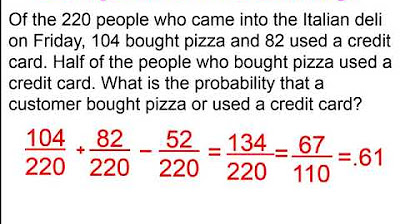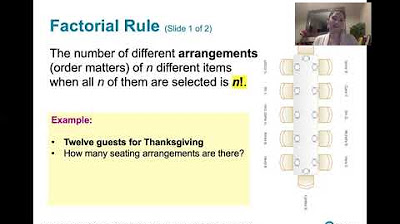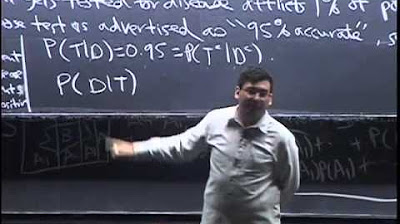Math 119 Chapter 4 part 3
TLDRThis educational video script covers key probability concepts, including the multiplication rule, conditional probability, and the distinction between dependent and independent events. It provides step-by-step examples using real-world scenarios, such as driving under the influence and polygraph tests, to illustrate calculations and logical reasoning. The script also delves into counting methods, factorials, and permutations, offering practical applications in horse racing and lock combinations to solidify understanding. The comprehensive guide aims to clarify complex statistical principles for students.
Takeaways
- 📚 The lesson covers the multiplication rule, complement rule, and conditional probability, emphasizing the formula P(A ∩ B) = P(A) * P(B|A).
- 🔄 It is clarified that the converse P(B|A) is not equivalent to P(A|B), highlighting the importance of understanding the given condition in probability calculations.
- 🚗 An example is provided to calculate the probability of a person being intoxicated given they had a driving accident, using the given probabilities of intoxicated driving, accidents, and intoxicated accidents.
- 📊 The use of a table is introduced to organize data for calculating probabilities in a polygraph test scenario, involving the probability of a positive test given the subject lied.
- 🤔 The script discusses the concept of dependent and independent events, using a lie detector test example to illustrate how the probability of a negative test result can differ based on whether the subject told the truth.
- 🎵 A survey example is given to demonstrate the use of a Venn diagram for calculating probabilities of overlapping sets, such as students liking country and gospel music.
- 🔢 The fundamental counting rule is explained, showing how to calculate the number of possible outcomes for a sequence of events with different options at each step.
- 🔐 An example of a combination lock is used to illustrate the calculation of possible combinations, highlighting the use of 'n' choose 'r' to determine the number of ways to select items from a set.
- 🏇 The concept of permutations is discussed in the context of horse racing, explaining how to calculate the number of ways to select horses in a specific order for an 'exacta' bet.
- 🎰 The difference between permutations and combinations is clarified, with the script using the example of selecting horses for a 'quinella' bet where order does not matter.
- 📉 The script concludes with the calculation of probabilities using permutations and combinations, emphasizing the use of factorials and calculator functions to simplify the process.
Q & A
What is the multiplication rule for probability?
-The multiplication rule for probability states that the probability of two independent events A and B occurring together is the product of their individual probabilities, i.e., P(A and B) = P(A) * P(B).
How do you calculate the conditional probability of event B given event A?
-To calculate the conditional probability of event B given event A, you divide the probability of both events A and B occurring by the probability of event A. This is expressed as P(B|A) = P(A and B) / P(A).
What is the formula for finding the probability of a person having a driving accident given that they are intoxicated?
-The formula used to find the probability of a person having a driving accident given that they are intoxicated is P(Intoxication|Accident) = P(Accident and Intoxication) / P(Accident).
What is the probability of a person being intoxicated given they had a driving accident, according to the script?
-Based on the script, the probability of a person being intoxicated given they had a driving accident is approximately 0.667 or 66.7%.
How does the script explain the difference between the probability of B given A and the probability of A given B?
-The script explains that the probability of B given A (P(B|A)) is not the same as the probability of A given B (P(A|B)). These are not interchangeable and represent different conditional probabilities.
What is the fundamental counting principle mentioned in the script?
-The fundamental counting principle states that if there are m ways one event can occur and n ways a second event can occur, then the two events together can occur in m * n ways.
How many different combinations can be made with a 5-digit code from 0 to 9?
-With a 5-digit code ranging from 0 to 9, there are 100,000 different combinations possible, which is calculated as 10^5 (ten to the power of five).
What is a factorial and how is it represented mathematically?
-A factorial, represented by the symbol '!', is the product of all positive integers up to a given number. For example, 5! = 5 * 4 * 3 * 2 * 1.
How does the script illustrate the difference between permutations and combinations?
-The script illustrates that permutations are arrangements where order matters, and different orders of the same items are considered distinct. Combinations, on the other hand, do not consider order, and the same items arranged in different orders are not considered distinct.
What is the probability of winning an exacta bet in horse racing, according to the script?
-The probability of winning an exacta bet, where the order of the first and second place horses matters, is 1 out of the number of permutations of selecting 2 horses from a field of 20, which is 380.
How does the script explain the calculation of probabilities for dependent and independent events?
-The script explains that for independent events, the probability of event B given event A should be the same as the probability of B without considering A. If these probabilities are not equal, the events are dependent, meaning the occurrence of one event affects the other.
Outlines
📘 Multiplication Rule, Complement, and Conditional Probability
The paragraph discusses the multiplication rule, complement, and conditional probability. It starts by explaining that the numbering may not line up with the homework and continues with the probability of events A and B occurring together. It details the process of finding the probability of B given A and emphasizes the importance of dividing by the probability of the given event. The paragraph then provides an example problem involving probabilities related to driving while intoxicated and driving accidents, showcasing how to calculate conditional probabilities using the provided formulas.
📊 Polygraph Test Probabilities
This paragraph focuses on calculating probabilities using a polygraph test example. It explains how to find the probability of a positive test result given that the subject lied, using a table to determine values. The paragraph also covers how to calculate the probability that a subject lied given a negative test result, and how to assess the accuracy of the test given that the subject told the truth. It concludes with a discussion on whether the test results are independent or dependent, emphasizing that in this case, they are dependent because the events affect each other.
🎵 Venn Diagram and Probability Calculation
This section introduces the use of Venn diagrams to calculate probabilities. It presents a problem involving college students' preferences for country and gospel music, illustrating how to set up a Venn diagram and calculate probabilities for different scenarios. The paragraph covers how to find the probability of liking country music but not gospel, the probability of liking gospel given they like country, and the probability of liking neither. It demonstrates the importance of correctly interpreting the overlapping sections of the Venn diagram.
🎓 Venn Diagram Example with Scholarships
This paragraph provides another Venn diagram example, focusing on scholarships. It explains how to determine the probability of receiving athletic and merit scholarships based on given probabilities. The section details the process of filling in the Venn diagram with the appropriate probabilities and calculating the probability of receiving a merit scholarship and the probability of not receiving either scholarship. It emphasizes the careful consideration needed when dealing with overlapping probabilities.
🔍 Contingency Tables and Independence Testing
The paragraph discusses using contingency tables to determine whether two events are independent. It explains how to calculate probabilities for events such as being very happy for married adults, given they are male or female. The section also covers how to test for independence by comparing the probabilities of being very happy given gender with the overall probability of being very happy. It concludes that happiness does depend on gender, as the probabilities differ.
🔢 Counting Methods and Fundamental Counting Rule
This section introduces methods for counting possible outcomes in various situations, focusing on the fundamental counting rule. It provides an example involving a combination lock with a five-digit code, explaining how to calculate the number of possible combinations. The paragraph also covers the factorial symbol and its use in calculating permutations, with an example involving five people standing in line. It highlights the significance of factorials in determining different arrangements.
🏇 Permutation Rule for Horse Racing
The paragraph explains the permutation rule when all items are different and provides a detailed example involving horse racing. It describes how to calculate the probability of winning an exacta bet by selecting two horses in the correct order out of a field of 20. The section demonstrates the formula for permutations and how to simplify it using factorials. It also shows how to use a calculator to find the number of permutations efficiently.
🔠 Permutations with Identical Items
This section discusses permutations when some items are identical, using an example with repeated letters. It explains how to calculate the number of distinct arrangements for a set of letters with repetitions by dividing the factorial of the total number of items by the factorials of the repeated items. The paragraph provides a step-by-step solution to the example problem, highlighting the importance of considering repeated elements in permutations.
🎟️ Combinations in Horse Racing
The paragraph covers combinations, emphasizing that order does not matter. It uses the same horse racing example to explain how to calculate the probability of winning a canela bet by selecting two horses regardless of their order. The section contrasts combinations with permutations, showing how to adjust the formula by including an additional factorial term. It demonstrates the use of a calculator to find the number of combinations and concludes with the probability of winning the bet.
Mindmap
Keywords
💡Multiplication Rule
💡Conditional Probability
💡Independence of Events
💡Complement of an Event
💡Venn Diagram
💡Factorial
💡Permutations
💡Combinations
💡Probability
💡Contingency Tables
Highlights
Introduction to the multiplication rule for complement and conditional probability.
Explanation of the formula for conditional probability and its application in problem-solving.
Clarification that the probability of B given A is not the same as the probability of A given B.
Example calculation involving New Year's Eve, driving while intoxicated, and accident probabilities.
Use of a formula to determine the probability of a person being intoxicated given they had a driving accident.
Introduction to a polygraph test scenario to find the probability of a subject lying given a positive test result.
Calculation of the probability using a contingency table and the complement rule.
Discussion on the probability of a negative test result indicating a subject lied, and its implications.
Exploration of the accuracy of lie detector tests and the dependency of test results on whether the subject told the truth.
Introduction to the use of Venn diagrams for visualizing probabilities in overlapping sets.
Example of creating a Venn diagram for college students' music preferences and calculating related probabilities.
Explanation of the probability of students liking neither country nor gospel music using the complement rule.
Application of the fundamental counting rule to determine the number of possible outcomes for a combination lock.
Introduction to factorials and their use in calculating the number of permutations.
Calculation of the number of ways people can stand in line using factorials.
Introduction to permutation and combination rules, and their differences in considering order.
Example of calculating the probability of winning an exacta bet in horse racing using permutations.
Explanation of how to calculate permutations when some items are identical using factorials.
Calculation of the probability of winning a quiniela bet in horse racing using combinations.
Summary of the use of calculator functions for nCr and nPr to simplify probability calculations.
Transcripts
Browse More Related Video
5.0 / 5 (0 votes)
Thanks for rating:





